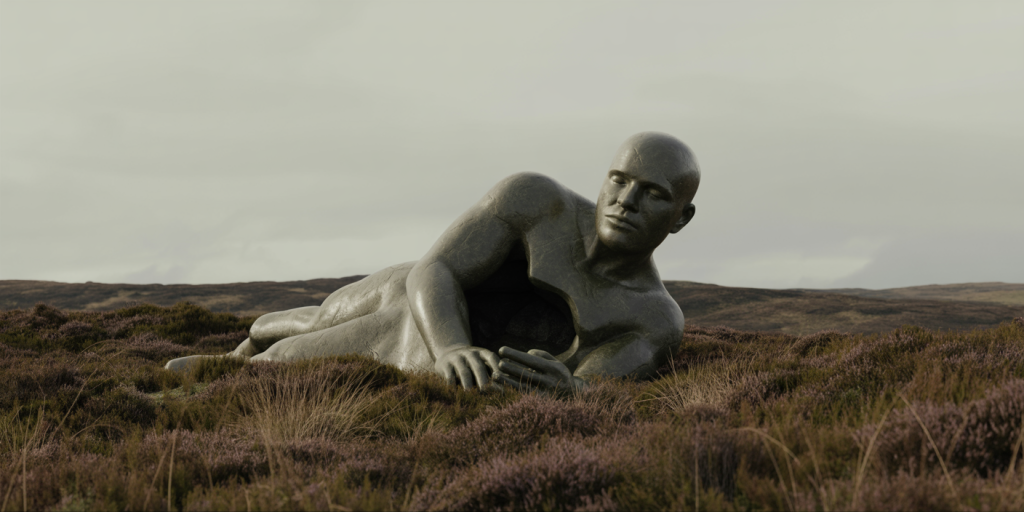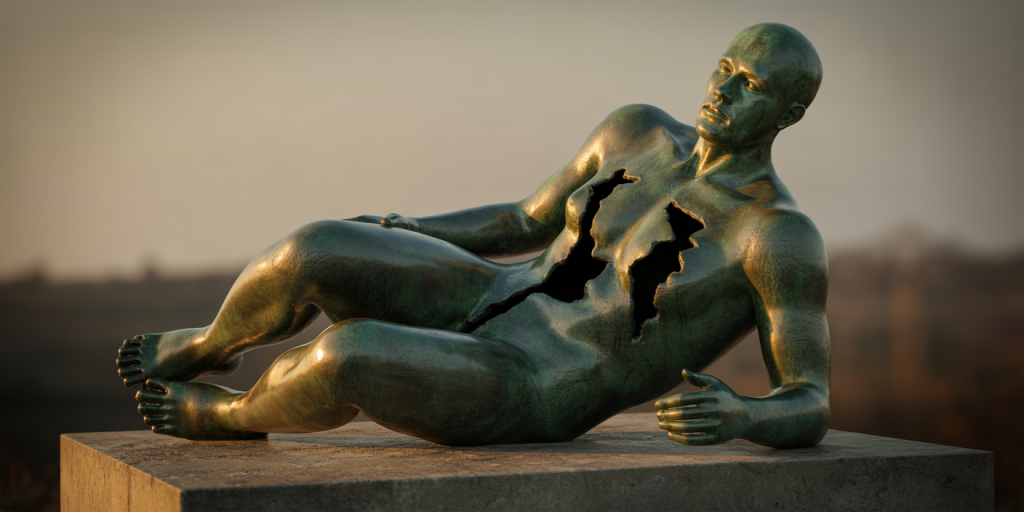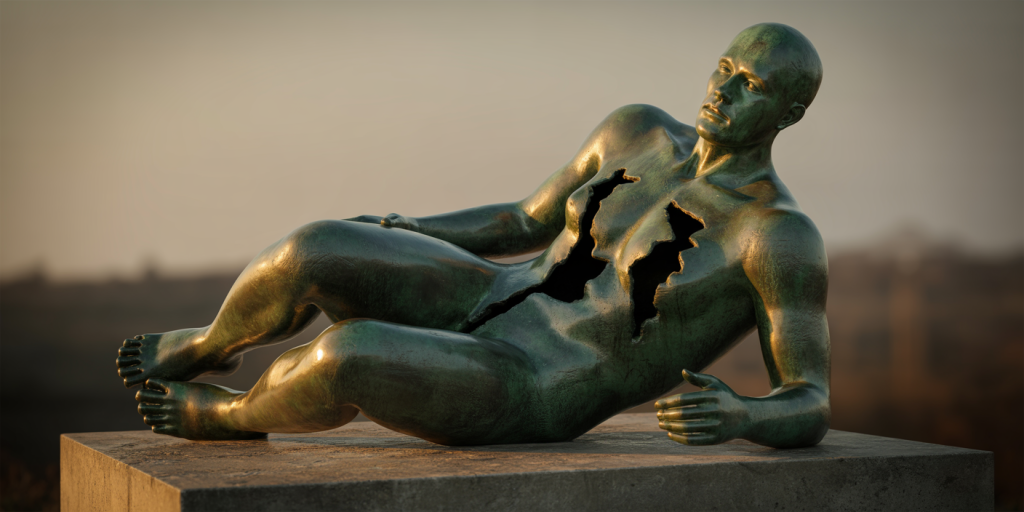Pain Becomes Shape in the Hands of Henry Moore
A Breath of Stone and Silence
In the hush between thunder and prayer, there exists a sculpture that seems to breathe. It is neither entirely flesh nor stone, but something in between—a solemn echo carved by time and tenderness. In Henry Moore’s hands, pain does not remain invisible. It acquires shape, it bends and opens, it arches and fractures. It is heavy yet hollow. Here, in the cavities of his reclining figures, the ache of being becomes form.
One does not merely view Moore’s work; one listens to it with the skin. There are murmurs in the curves, whispers in the negative space. His sculptures are the fossilized remnants of emotion—empathy embalmed in stone. Through them, the artist transforms suffering into something you can trace with your fingertips, something you can feel without wounding yourself.
Table of Contents
- Wounds in Stone
- The Cradle of Void
- Torsos Like Broken Mountains
- The Elegy of Reclining Forms
- Fingers that Carved Absence
- Caverns of Light and Memory
- Between Flesh and Fossil
- The Silent Rhetoric of Holes
- Abstract Sorrows and Anatomical Echoes
- The Skin that Remembers
- Sculpting the Unspeakable
- Primordial Postures
- The Feminine as Shelter and Ruin
- Earthbound Angels
- War Touched Forms
- Gravity as Grief
- Humanity without Face
- A Spine Etched by Time
- Dialogues in Bronze
- Notes from the Edge of Form
Wounds in Stone
Henry Moore’s sculptures are less concerned with bodies than with what bodies have endured. They are not illustrations of anatomy but vessels of trauma. Each ridge and cavity is a wound petrified, a scar made eternal.
Rather than conceal pain, Moore lays it bare. He exposes the body’s fragility through the material strength of stone and bronze. His figures do not stand triumphant—they recline, curl, collapse. They yield. Their postures evoke exhaustion, resilience, or surrender, but never indifference. These are not idealized beings. They are mortals who have endured.
The Cradle of Void
The voids in Moore’s sculptures are not empty. They are intimate spaces that remember presence. Cavities in his forms do not subtract—they breathe. The negative space is an invitation, a metaphysical embrace of all that cannot be held.
Moore once said that a hole could have as much shape as a solid mass. In his hands, the void becomes a sanctuary. It cradles memory. It allows light to enter the sculpture, to pierce through the shell of form and illuminate pain from within.

Torsos Like Broken Mountains
Moore’s torsos resemble weathered rock formations—like mountain ranges worn down by time and wind. There is something geological about them, something patient and enduring. The curvature of a spine, the erosion of a limb—these are not flaws, but strata.
The body in Moore’s world is a terrain. It invites exploration, but not the gaze of conquest. Instead, it asks for reverence. The torso does not stand as a pillar, but crumbles like a cliff. The breakage is not violence—it is the quiet truth of all things that live.
The Elegy of Reclining Forms
The reclining figure is one of Moore’s most recurring motifs. But unlike traditional reclining nudes, Moore’s versions are not sensual. They are contemplative, haunted. They lie not in seduction but in aftermath.
These forms evoke funerary sculpture, yet they are not lifeless. They rest in the same way that grief rests—never completely still, always vibrating with memory. Their silence is not peace, but the pause before mourning speaks.
Fingers that Carved Absence
Moore’s technique is not merely additive—it is subtractive, elemental. He carves not to shape, but to reveal. With each chisel stroke, he unveils what already sleeps within the block. And what he reveals is absence.
His tools mimic time’s own hand. Weathered, punctured, softened—his forms look as though they’ve been unearthed from some forgotten epoch, bearing the marks of erosion and tenderness alike. The artist becomes an archaeologist of human feeling, excavating pain that once had no form.
Caverns of Light and Memory
Light plays a sacred role in Moore’s sculptures. It slides into hollows and crawls across coarse surfaces. The interplay of shadow and glow does not simply enhance the form—it animates it.
Moore’s cavities capture the memory of what was once whole. They are not merely aesthetic devices but psychological spaces. You look into them and remember something you didn’t know you forgot: a mother’s embrace, the shape of grief, the silence after loss.
Between Flesh and Fossil
In Moore’s art, the line between organic and ancient is blurred. His sculptures seem to straddle epochs. They could be future relics or prehistoric totems. Their tactility evokes both flesh and fossil.
The skin of these figures—grooved, cracked, coarse—feels alive even as it resembles stone. There’s a strange warmth in their weight. You want to press your cheek against them, not for comfort, but for communion.
The Silent Rhetoric of Holes
A hole in Moore’s work is never just absence—it is speech. It says what the form cannot. It is a mouth without voice, a wound that confesses.
These apertures are not random. They are choreographed. Their placement—at the center of a torso, within the breast, behind the eye—suggests emotion, loss, insight. They let the sculpture breathe, but more than that—they let it feel.
Abstract Sorrows and Anatomical Echoes
Moore’s figures are abstractions, but they never lose their humanity. They flirt with distortion yet remain recognizable. This balance is what allows them to carry emotion so potently.
You recognize a shoulder, a ribcage, a hip—but only enough to empathize, not to categorize. His abstraction does not estrange; it invites. It’s the kind of abstraction that feels more truthful than realism—because pain itself rarely takes a neat shape.
The Skin that Remembers
The texture of Moore’s sculptures is a language of its own. Ridges like veins, grooves like muscle memory. The skin remembers touch, war, childbirth, loss. It remembers without ever saying a word.
You see the tool marks. You see time etched into surface. These are not polished, pristine bodies. They are weathered. They have endured love and labor, hunger and heat, death and dream.
Sculpting the Unspeakable
Much of what Moore gives form to cannot be said. The silence of stone mirrors the silence of suffering. But in his hands, that silence becomes expressive.
He sculpts not what happened, but how it felt. The ache of waiting, the longing for safety, the weight of existence. His sculptures are emotional translations. They are what you feel when there are no words left.
Primordial Postures
Many of Moore’s figures adopt poses that feel ancient—kneeling, reclining, curled. These are not postures of civilization, but of survival. They seem to speak the first language of the body.
Their simplicity is deceptive. In their primal gestures, they carry entire cosmologies of feeling. A mother cradling a child. A body curled around its wound. A being seeking the earth’s warmth.
The Feminine as Shelter and Ruin
Moore’s female forms are often vast, sheltering, cavernous. But they are not idealized goddesses. They are terrains of nurture and sorrow. They are not passive but powerful—powerful because they endure.
Their hollows become wombs, or graves, or houses. The feminine in Moore’s art is not object but origin. It is the site of life and the memory of death.
Earthbound Angels
Moore’s sculptures seem to belong to the ground. Even when elevated, they lean, recline, or collapse. They do not ascend. And yet, there is something sacred in them—like angels who chose to stay.
Their mass is devotional. Their stillness, a kind of prayer. They remind us that holiness can be heavy. That beauty can be burdened.
War-Touched Forms
Much of Moore’s most evocative work was shaped during and after World War II. He witnessed the Blitz, saw families huddled in underground shelters, and drew them as silhouettes of resilience.
These experiences seeped into his sculptures. The figures curl like civilians in bunkers, fold like children on their mothers’ laps. They carry the psychic architecture of survival.

Gravity as Grief
There is always a sense of downward pull in Moore’s work. His figures do not defy gravity; they surrender to it. They sink into the plinth, the grass, the space around them.
This gravitational honesty becomes metaphor. It evokes the emotional weight we carry—the way sorrow pulls us earthward. Moore does not romanticize grief. He honors its heaviness.
Humanity without Face
Many of Moore’s sculptures are faceless, yet intensely human. By removing individual identity, he universalizes emotion. These are not portraits—they are states of being.
Their facelessness is not a loss but a mirror. We project ourselves into the voids. We feel our own ache reflected in their silence. In erasing the face, Moore reveals the soul.
A Spine Etched by Time
In several of Moore’s works, the spine becomes a focal point—carved like a canyon, emphasized like a tree’s trunk. The spine is more than anatomy. It is narrative.
It tells of burden carried, of moments stood tall, of bending without breaking. His sculptures often arc like bodies under pressure, but the spine remains—the one line that endures.
Dialogues in Bronze
Though Moore worked in stone and wood, his bronzes achieve a peculiar warmth. Bronze becomes fleshlike. It gleams in the sun and glows in the dusk. It breathes.
These bronzes carry dialogue. Between light and dark, weight and air, presence and absence. They seem less cast than conjured. As though Moore didn’t pour metal, but memory.

Notes from the Edge of Form
Moore never fully abandoned the human form, but he never imprisoned it either. He hovered at its edge—just enough flesh to anchor feeling, just enough abstraction to free it.
His genius lies in knowing what to leave out. A gesture unfinished. A limb suggested. A face erased. It is at the edge of form that emotion emerges most vividly, like music heard through a wall.
FAQ
Q: Who was Henry Moore?
A: Henry Moore (1898–1986) was a British sculptor known for his semi-abstract monumental sculptures. He is one of the most influential sculptors of the 20th century.
Q: What materials did Moore use?
A: Moore worked with a variety of materials including stone, bronze, and wood. His large public commissions were often cast in bronze.
Q: Why are his sculptures often abstract?
A: Moore used abstraction to evoke universal human experiences, focusing more on emotion, form, and memory than literal representation.
Q: What inspired Moore’s recurring reclining figures?
A: The reclining figure was a lifelong motif for Moore, symbolizing rest, nature, and resilience. It also allowed him to explore horizontal form and internal voids.
Q: How did World War II affect his art?
A: Moore’s drawings of people sheltering during the Blitz deeply influenced his depiction of suffering and survival, leading to more introspective and emotive forms.
Q: Are Moore’s sculptures symbolic?
A: Yes. Moore’s forms often carry deep symbolic weight—wombs, wounds, cradles, tombs—all embodied in abstract, tactile form.
The Gravity of Beauty: Final Reflections
Henry Moore’s sculptures do not ask to be understood—they ask to be felt. They are not puzzles to solve but prayers to dwell in. Pain becomes form. Form becomes empathy.
He showed that beauty need not be perfect, that suffering can be sublime. In the echo of his hollows, in the slope of his silent spines, we find ourselves. Not whole, but human.
Through Moore, we learn that to carve is to remember. That even stone can grieve. And that sometimes, the shape of sorrow is the most sacred form of all.
